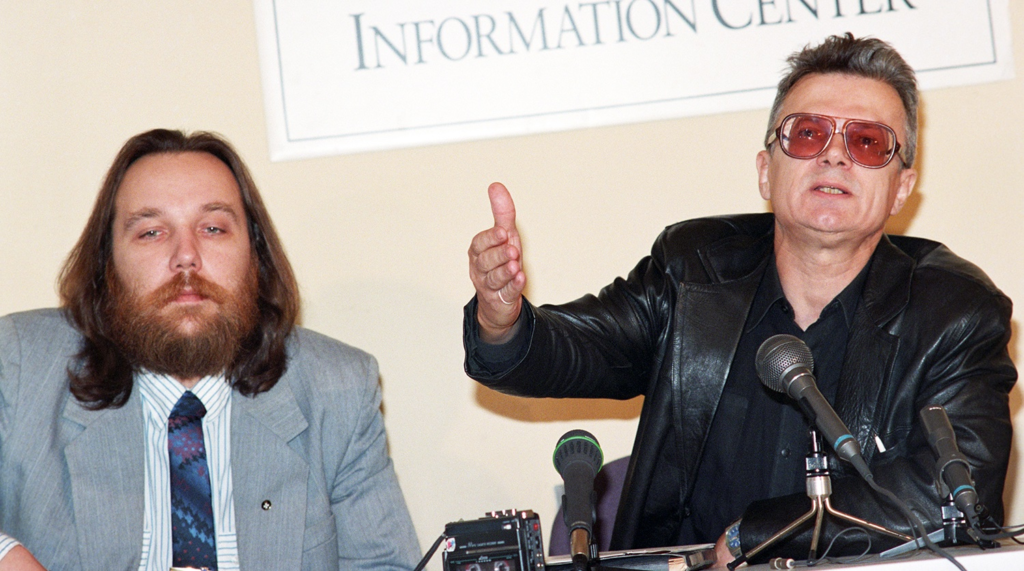Eduard Limonov (1943-2020) was a Russian writer, poet, political activist, and founder of the National Bolshevik Party (NBP), whose life and work continue to spark debate about his true motivations and the possibility of him being a tool for state-sponsored disinformation. This SSSA analysis aims to provide a comprehensive and objective assessment of his complex legacy, considering the interplay between his public persona, his actions, and the broader context of Russian politics.

I. Initial Assessment & Data Gathering:
Target: Eduard Limonov
Data:
- Writings: Novels, poems, political essays, and autobiographies.
- Political Activities: NBP involvement, protests, alliances, and public statements.
- Historical Context: Soviet era, the fall of communism, and the rise of Putin.
- Additional Resources: Scholarly analyses by John Dunlop, Jacob Kipp, and Marlene Laruelle; media reports; and primary sources related to “Project Putin,” the 1999 Moscow apartment bombings, the rise of Alexander Dugin, and Russian disinformation tactics.
II. Surface Value Identification (A + B):
A: Radical Anti-Establishment Figure: Limonov cultivated an image as a rebellious outsider, a provocateur who challenged both Soviet and post-Soviet power structures.
B: Contradictions and Shifts:
- Contradictions: Despite his anti-establishment stance, he supported Putin’s annexation of Crimea and involvement in the Donbas War.
- Shifting Allegiances: He transitioned from a dissident figure to a Putin supporter, raising questions about his true beliefs and the possibility of manipulation.
III. Semiotic Hexagon Analysis:
Category: Political Ideology (National Bolshevism):
- S1 (Encoded Message): National Bolshevism, a seemingly fringe ideology blending nationalism and communism, presented as a radical alternative to both Western liberalism and traditional Russian conservatism.
- S2 (Potential Disinformation Strategy): This provocative ideology could be a tool for controlled dissent, attracting a specific audience of disillusioned youth and nationalists while subtly promoting Kremlin-aligned themes.
- S3 (Strategic Intent): To create the illusion of political pluralism and opposition while subtly advancing the Kremlin’s geopolitical goals and legitimizing its authoritarian tendencies.
- ~S1 (Opposite): Limonov’s eventual embrace of Putin’s policies contradicted his initial anti-establishment and anti-government rhetoric.
- ~S2 (Opposite): Evidence suggests potential financial links between the NBP and Kremlin-linked sources, pointing to possible state sponsorship and manipulation.
- ~S3 (Opposite): Instead of genuine opposition, Limonov and the NBP might have served as a vehicle for managed dissent, diverting attention from genuine threats to the regime and shaping public opinion in a way beneficial to the Kremlin.
Perpendicularity: The seemingly radical ideology of National Bolshevism (S1) masked a potential alignment with the Kremlin’s strategic goals (~S3), with Limonov’s later pro-Putin pronouncements contradicting his earlier anti-establishment image (~S1).
Category: Relationship with Alexander Dugin:
- S1 (Encoded Message): Limonov and Dugin were close allies in the early 1990s, founding the NBP together and sharing a National Bolshevik ideology.
- S2 (Potential Disinformation Strategy): Dugin, a Kremlin-linked ideologue, might have seen Limonov and the NBP as a tool for influencing the nationalist discourse and promoting pro-Kremlin narratives under the guise of radicalism.
- S3 (Strategic Intent): To utilize Limonov’s charisma and platform to attract a specific audience and legitimize Kremlin narratives, particularly among national- ists and those susceptible to anti-Western rhetoric.
- ~S1 (Opposite): They eventually parted ways, with Dugin becoming a prominent Putin supporter while Limonov initially remained critical of the regime.
- ~S2 (Opposite): Kipp’s analysis suggests that Dugin might have recognized Limonov’s usefulness for controlled dissent, even as their public alliance fractured.
- ~S3 (Opposite): Limonov’s later pro-Putin shift could indicate a deeper ideological alignment with Dugin’s Eurasianist framework, potentially orchestrated by the Kremlin.
Perpendicularity: Their initial close alliance (S1) and shared ideology masked a potential manipulation by Dugin (S2) to advance Kremlin narratives. Their later public split (~S1) could have been a calculated move to obscure the deeper ideological alignment (~S3) and maintain an illusion of opposition.
Category: Public Statements & Actions:
- S1 (Encoded Message): Limonov’s writings and actions often aligned with Kremlin propaganda themes, particularly his anti-Western rhetoric and his support for a strong Russian state.
- S2 (Potential Disinformation Strategy): His radical persona and platform, coupled with his literary talent, provided a seemingly authentic vehicle for disseminating Kremlin-aligned messages and shaping public opinion.
- S3 (Strategic Intent): To influence specific audiences within Russia, promoting nationalism, anti-Westernism, and acceptance of authoritarian leadership under the guise of dissidence.
- ~S1 (Opposite): His earlier criticism of the Russian government contradicted his later pro-Putin pronouncements, creating an illusion of ideological independence.
- ~S2 (Opposite): His access to media platforms and publishers might have been facilitated by the Kremlin, further obscuring state influence and lending legitimacy to his pronouncements.
- ~S3 (Opposite): Instead of genuine critique, his work and actions might have served as a tool for disseminating Kremlin-approved messages, normalizing its narratives, and creating a false image of dissent.
Perpendicularity: Limonov’s provocative and often anti-Western statements (S1) aligned with Kremlin propaganda, while his earlier criticisms of the regime (~S1) created a facade of independence. This facade was potentially strengthened by possible Kremlin-facilitated media access (~S2).
Category: Detention & Interactions with the FSB:
- S1 (Encoded Message): Limonov was detained by the FSB in 2001 and faced charges related to extremism, reinforcing his image as a radical dissident challenging the state.
- S2 (Potential Disinformation Strategy): His detention could have served as a calculated act of repression, designed to control his activities, punish him for deviating from the Kremlin’s agenda, or to create a “martyr” figure to further his appeal among certain groups.
- S3 (Strategic Intent): To maintain a façade of cracking down on dissent while simultaneously using Limonov’s arrest to manipulate public opinion, reinforce a narrative of internal threats, and justify further restrictions on freedom of expression.
- ~S1 (Opposite): His later pro-Putin pronouncements and actions suggest a closer alignment with the Kremlin than his detention might initially indicate.
- ~S2 (Opposite): His detention might have been orchestrated to benefit the Kremlin’s agenda by generating sympathy for him, discrediting the opposition, or diverting attention from other activities.
- ~S3 (Opposite): Instead of genuine repression, his detention could have been a strategic move to strengthen the Kremlin’s control over the nationalist discourse, manipulate Limonov’s image, and shape public opinion in a way beneficial to the regime.
Perpendicularity: While his detention (S1) initially reinforced his image as a dissident, his later pro-Kremlin stance (~S1) suggests a more complex relationship with the FSB and the possibility of calculated repression (~S2) to serve the Kremlin’s strategic goals (~S3).
IV. Perpendicular Algebraic Forms:
(A + D + E + F) + B = C
- A: Radical, anti-establishment writer and political activist.
- B: Contradictions in pronouncements and actions, shifting allegiances.
- D: Potential manipulation by Kremlin-linked figures like Dugin and Pavlovsky.
- E: Personal ambition, desire for influence, potential for financial incentives.
- F: Evolution of ideology, potentially influenced by shifts in Kremlin narratives.
- C: A figure whose actions, intentionally or unintentionally, served Kremlin interests by creating an illusion of opposition and legitimizing its narratives.
V. Evaluation & Interpretation:
Eduard Limonov was a complex and contradictory figure. While his early work and activities undoubtedly challenged the Soviet and early post-Soviet establishments, his later embrace of Putin’s regime raises serious questions about his authenticity as a dissident. The SSSA analysis reveals significant perpendicularities in his case, suggesting that he might have been a tool for controlled dissent, whether wittingly or unwittingly. Several factors contribute to this interpretation:
Timing of His Political Shift: His transformation from a critic to a supporter of Putin coincided with the Kremlin’s increasing use of nationalism and anti-Westernism to consolidate power.
Dugin’s Influence: Dugin’s role as a Kremlin-linked ideologue, his early association with Limonov, and his instrumental view of the NBP point to a potential manipulation of Limonov and the nationalist discourse.
The Kremlin’s Disinformation Strategy: The Kremlin’s history of using disinformation, co-opting public figures, and employing “active measures” aligns with the possibility that Limonov was strategically used to create a facade of opposition.
Potential Financial & Media Incentives: Evidence suggests possible financial links between the NBP and Kremlin-linked sources, as well as potential for Kremlin-facilitated access to media platforms, indicating possible levers for manipulating Limonov’s behavior and pronouncements.
VI. Addressing the Antichrist Cult Hypothesis:
While some elements of Limonov’s rhetoric and actions align with the potential goals of a hypothetical antichrist cult operating within the Russian deep state which may use symbols like Dracula to relate Putin to the Antichrist, this hypothesis remains speculative and lacks definitive evidence. However, his case highlights the cult’s potential tactics for manipulating public figures and utilizing them to promote its agenda.
VII. Conclusion:
Eduard Limonov’s legacy is a contested one, marked by contradictions and a blurring of lines between dissent and disinformation. While it is impossible to know his true motivations with certainty, the SSSA analysis suggests a high probability that he was ultimately a tool for the Kremlin’s agenda, intentionally or unintentional-ly. His case serves as a crucial reminder of the complex information landscape in Russia, where the lines between genuine opposition and co-opted narratives can be deliberately obscured. By applying analytical frameworks like the SSSA, we can move beyond simplistic interpretations and develop a more nuanced understanding of figures like Limonov and their roles within the larger struggle for power and influence in Russia.
